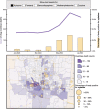Enhancing drug checking services for supply monitoring: perspectives on implementation in syringe service programs in the USA
- PMID: 38218980
- PMCID: PMC10788002
- DOI: 10.1186/s12954-023-00924-5
Enhancing drug checking services for supply monitoring: perspectives on implementation in syringe service programs in the USA
Abstract
Background: Shifts in the US drug supply, including the proliferation of synthetic opioids and emergence of xylazine, have contributed to the worsening toll of the overdose epidemic. Drug checking services offer a critical intervention to promote agency among people who use drugs (PWUD) to reduce overdose risk. Current drug checking methods can be enhanced to contribute to supply-level monitoring in the USA, overcoming the selection bias associated with existing supply monitoring efforts and informing public health interventions.
Methods: As a group of analytical chemists, public health researchers, evaluators, and harm reductionists, we used a semi-structured guide to facilitate discussion of four different approaches for syringe service programs (SSPs) to offer drug checking services for supply-level monitoring. Using thematic analysis, we identified four key principles that SSPs should consider when implementing drug checking programs.
Results: A number of analytical methods exist for drug checking to contribute to supply-level monitoring. While there is likely not a one-size-fits-all approach, SSPs should prioritize methods that can (1) provide immediate utility to PWUD, (2) integrate seamlessly into existing workflows, (3) balance individual- and population-level data needs, and (4) attend to legal concerns for implementation and dissemination.
Conclusions: Enhancing drug checking methods for supply-level monitoring has the potential to detect emerging threats in the drug supply and reduce the toll of the worsening overdose epidemic.
Keywords: Drug checking; Drug supply; Fentanyl test strips; Harm reduction; Immunoassay strips; Implementation research; LC–MS; Overdose prevention; Public health.
© 2024. The Author(s).
Conflict of interest statement
No competing interests to disclose.
Figures



Similar articles
-
Drug checking as a potential strategic overdose response in the fentanyl era.Int J Drug Policy. 2018 Dec;62:59-66. doi: 10.1016/j.drugpo.2018.10.001. Epub 2018 Oct 22. Int J Drug Policy. 2018. PMID: 30359874
-
Responding to a surge in overdose deaths: perspectives from US syringe services programs.Harm Reduct J. 2022 Jul 19;19(1):79. doi: 10.1186/s12954-022-00664-y. Harm Reduct J. 2022. PMID: 35854351 Free PMC article.
-
Recommendations from people who use drugs in Philadelphia, PA about structuring point-of-care drug checking.Harm Reduct J. 2024 Jan 30;21(1):26. doi: 10.1186/s12954-024-00937-8. Harm Reduct J. 2024. PMID: 38287409 Free PMC article.
-
Stimulant safe supply: a potential opportunity to respond to the overdose epidemic.Harm Reduct J. 2020 Jan 10;17(1):6. doi: 10.1186/s12954-019-0351-1. Harm Reduct J. 2020. PMID: 31924209 Free PMC article. Review.
-
Paper spray mass spectrometry: A new drug checking tool for harm reduction in the opioid overdose crisis.J Mass Spectrom. 2019 Sep;54(9):729-737. doi: 10.1002/jms.4431. J Mass Spectrom. 2019. PMID: 31432563 Review.
Cited by
-
Drug-Checking and Monitoring New Psychoactive Substances: Identification of the U-48800 Synthetic Opioid Using Mass Spectrometry, Nuclear Magnetic Resonance Spectroscopy, and Bioinformatic Tools.Int J Mol Sci. 2025 Feb 28;26(5):2219. doi: 10.3390/ijms26052219. Int J Mol Sci. 2025. PMID: 40076839 Free PMC article.
-
Is fentanyl in everything? Examining the unexpected occurrence of illicit opioids in British Columbia's drug supply.Harm Reduct J. 2025 Mar 10;22(1):28. doi: 10.1186/s12954-025-01189-w. Harm Reduct J. 2025. PMID: 40065423 Free PMC article.
-
Multidisciplinary Guidance to Care for Persons With Xylazine-Associated Wounds.Open Forum Infect Dis. 2025 May 15;12(6):ofaf299. doi: 10.1093/ofid/ofaf299. eCollection 2025 Jun. Open Forum Infect Dis. 2025. PMID: 40453883 Free PMC article. Review.
References
Publication types
MeSH terms
Substances
Grants and funding
LinkOut - more resources
Full Text Sources
Research Materials

